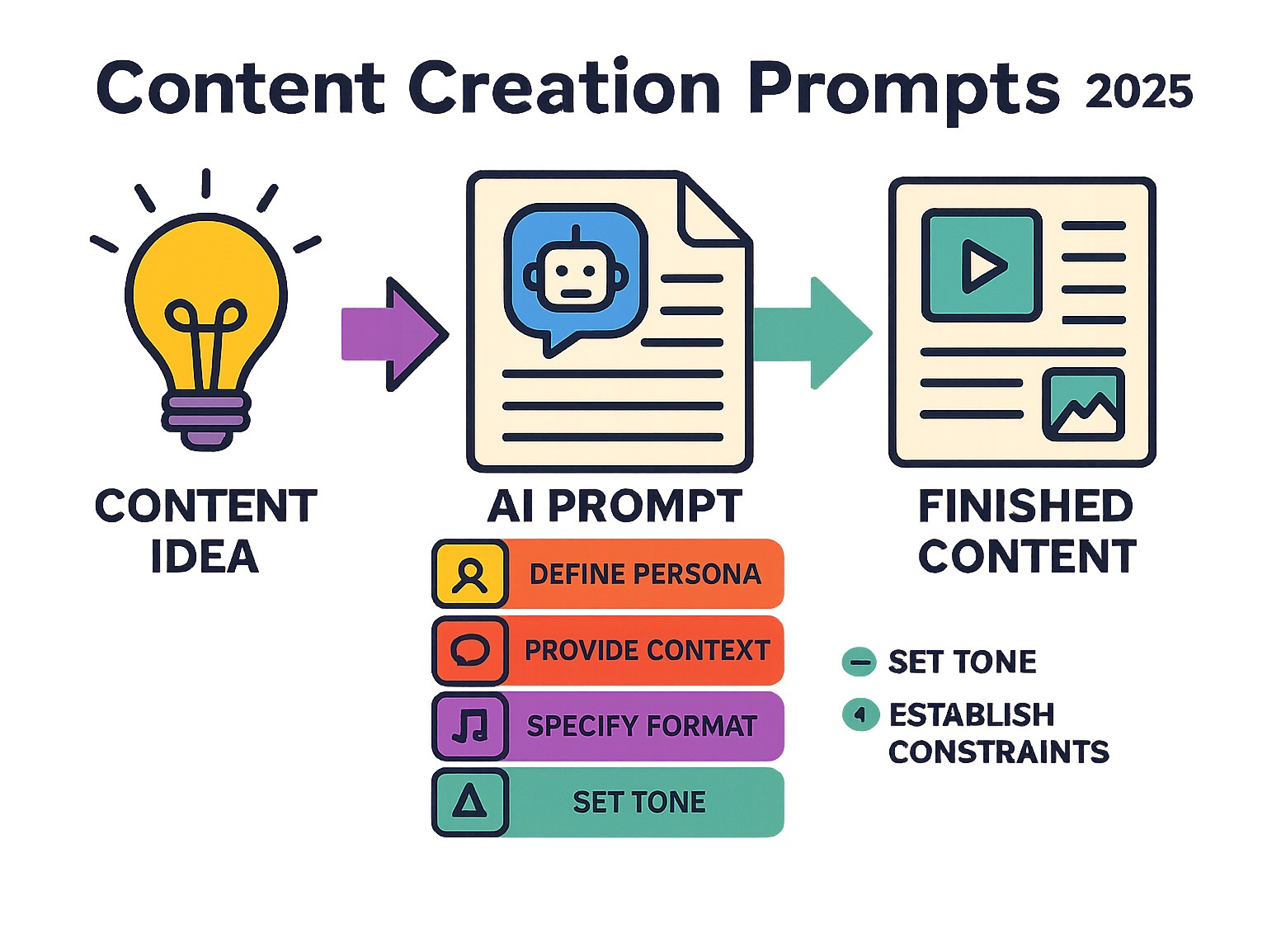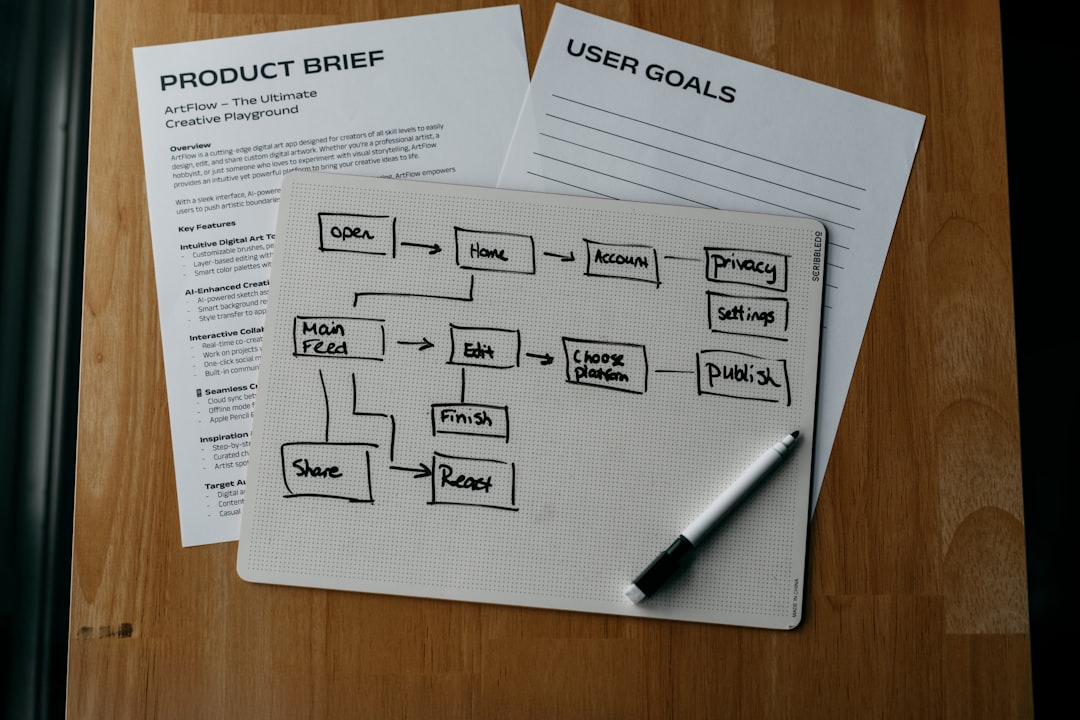Unlock Your Content Flow: Essential Prompts for Creators
From Writer's Block to Content Gold: The AI Prompt Playbook.

Content creation prompts are specific instructions you give to AI tools like ChatGPT, Claude, or Gemini to generate blog posts, social media content, video scripts, and other marketing materials. They work by providing the AI with clear context, desired format, tone, and constraints to produce relevant, high-quality output.
Quick Reference - Essential Content Creation Prompts:
- Blog Content: "Write a 1,500-word blog post about [topic] for [audience], using a conversational tone and including 3 actionable tips"
- Social Media: "Create 5 Instagram captions for [product/service] that are under 150 characters and include relevant hashtags"
- Video Scripts: "Write a 60-second explainer video script for [product] that addresses [pain point] and includes a clear call-to-action"
- Email Marketing: "Generate 10 subject line variations for a [campaign type] email targeting [audience]"
- Ad Copy: "Create compelling Facebook ad copy for [product] that highlights [benefit] in under 90 characters"
Most weeks, content creators stare blankly at their screens, wondering what to post next. It's hard. Coming up with fresh content on a daily basis isn't just time-consuming - it can be downright frustrating.
But here's the thing: 42% of marketers already use AI specifically for generating social media captions, and they're seeing real results. The difference between "meh" AI output and brilliant content usually comes down to one thing - a well-crafted prompt.
Think of prompts as your recipe for success. Just like you wouldn't call a pizza place and say "gimme one of those pizzas," you shouldn't ask AI to "write something about marketing." The more specific your instructions, the better your results.
The best part? You don't need to start from scratch. There are proven prompt patterns that work across industries, platforms, and content types. Once you master these templates, you'll never face a blank page again.

The Anatomy of a Perfect Prompt: 7 Principles for High-Quality AI Output
Creating effective content creation prompts is like communicating with a brilliant but literal assistant. The better your explanation, the better the results. It's that simple.
If you just told a pizza place "I want food," you'd get something, but not what you wanted. The same applies to AI prompts. Garbage in, garbage out isn't just a catchy phrase; it's the golden rule of prompt engineering.
The good news? Once you understand these seven core principles, you'll craft prompts that consistently deliver high-quality content, avoiding generic or off-target responses.

Define the Persona and Role
Tell your AI who to be before telling it what to do. Starting with "Act as a seasoned email marketing expert..." or "You are a witty social media manager..." gives the AI a personality and expertise level to work from.
This is about context and perspective, not just tone. A prompt asking AI to act as a startup founder will generate different content than one asking it to be a corporate communications director, even on the same topic.
The persona you choose should match both your target audience and your brand voice. If you're writing for busy entrepreneurs, have the AI adopt that mindset. If your brand is playful and irreverent, choose a persona that reflects that energy.
State a Clear Task with Action Verbs
Once the AI has its role, it needs a clear task. This is where action-oriented language is key. Words like "Generate," "Write," "Create," "Summarize," "Analyze," and "Brainstorm" give clear direction.
Instead of saying "I need something about social media trends," try "Generate 10 trending social media post ideas for small businesses in 2024." The second version leaves no room for confusion about what you want.
Provide Rich Context and Background
Like ordering a pizza, be specific. Context is king in AI prompting, and most people don't provide enough.
Your AI needs to understand your brand information, unique value, product details, campaign goals, and key messaging. The more background you provide, the more the AI can tailor its response. Don't worry about making your prompt too long; detailed context almost always leads to better results.
Specify the Format and Structure
AI doesn't automatically know format requirements. You must spell out the format you want, including word count limits, character constraints, and structural elements.
Want a blog post with specific HTML subheadings? Say so. Need exactly 280 characters for Twitter? Make that crystal clear. Looking for a table format or a listicle structure? Don't assume the AI will guess correctly.
This step prevents getting a 1,000-word essay when you needed a 50-word caption.
Set the Tone and Style
The tone makes your content come alive. The difference between conversational and professional, or witty and empathetic, can make or break its connection with your audience.
Don't just say "make it engaging"—be specific about the emotional tone you want. Want something that feels humorous but not silly? Professional but still approachable? Use a tool like the Feelings Wheel to help you target the right emotional tone.
Establish Constraints and Limitations
It may seem counterintuitive, but limitations boost creativity. Clear boundaries—like word counts, keywords to include or avoid, or topics to steer clear of—help the AI focus its creative energy.
Think about character limits for social platforms, keywords you need for SEO, or information you want to avoid mentioning. These constraints ensure your content is usable, not just well-written.
Ask for Multiple Versions
Always ask for multiple versions or variations. This provides choices for A/B testing headlines, experimenting with angles, and finding the perfect fit.
Whether brainstorming ideas or refining drafts, having several options lets you pick the best elements from each and create something even better. Plus, it gives you backup content for future use.
The beauty of iterative refinement is that each version teaches you what works, making your next prompt more effective.
Your Ultimate Library of Content Creation Prompts
Now that we understand the anatomy of a perfect prompt, let's dive into practical examples. These content creation prompts are your secret weapon for sparking creativity, streamlining your workflow, and ensuring your AI-generated content hits the mark.

When writer's block strikes, these 5 quick prompts can get your creative juices flowing:
- "Brainstorm 10 unique angles for a blog post about [topic] for [target audience]."
- "Generate 5 engaging social media post ideas for [product/service] that highlight [specific benefit] in a [tone] voice."
- "Rewrite this paragraph: '[insert paragraph]' to be more [tone] and concise."
- "Create a list of 3 common misconceptions about [industry/topic] and provide a brief explanation for each."
- "Develop 5 catchy headlines for an article about [topic] that appeal to [target audience]."
The beauty of these prompts is their flexibility. You can adapt them to any industry, any brand voice, and any platform. Think of them as your creative emergency kit.
Prompts for Engaging Social Media Posts
AI shines here. With 42% of marketers already using AI for captions, you're keeping up, not experimenting. Each social platform has a unique personality, and your prompts must reflect that.
For Instagram captions, try this approach: "Craft three engaging captions for an Instagram post about [content topic] that connects with [target audience]. Include 3-5 relevant hashtags and one emoji. Keep each caption under 125 characters." This gives you options while respecting Instagram's visual-first culture.
LinkedIn posts require a more professional touch. Use: "Write a compelling LinkedIn post that showcases the benefits of [product/service] to [target audience]. Focus on professional insights and include a clear call-to-action. Make sure the first 140 characters are hook-worthy before the 'see more' cutoff." LinkedIn users are scrolling fast - you need to grab them immediately.
Twitter threads are perfect for breaking down complex topics. Try: "Create a Twitter thread of 5-7 tweets on [topic], ensuring each tweet builds on the previous one. Keep each tweet under 280 characters and include relevant hashtags." The key is maintaining flow while respecting character limits.
For Facebook posts, engagement is everything: "Create three Facebook post ideas about [content topic] that resonate with [target audience]. Include a clear call-to-action, suggest visual elements, and add relevant hashtags." Facebook's algorithm loves engagement, so prompts that encourage interaction work best.
TikTok moves fast and trends faster: "Develop 10 TikTok video concepts for the [theme/niche] community, complete with captions and hashtags. Focus on trending sounds and visual storytelling." The magic happens when you combine trending elements with your unique message.
Don't forget interactive content either. For polls and quizzes, use: "Create a social media poll about [topic] that educates while engaging your audience. Provide 3-4 multiple-choice options." For giveaways, try: "Write a compelling giveaway post for [specific occasion] that drives engagement. Include clear rules and entry requirements."
Prompts for SEO-Optimized Blog Content
AI excels at SEO-optimized blog content. The trick is balancing search engine requirements with genuine reader value.
Start with blog post outlines using: "Generate a comprehensive outline for a 1500-word article titled '[Proposed Title]' targeting [audience]. Include an introduction, 3-4 main H2 sections, 2-3 H3 subheadings per section, a conclusion, and 3-5 FAQ questions. Suggest keyword placements for SEO." This gives you a roadmap that both readers and search engines will love.
Headlines can make or break your content. Try: "Generate 10 SEO-friendly headline variations for a blog post about [topic] targeting [keyword]. Mix number-based, question-based, and benefit-driven headlines." Having options lets you A/B test what resonates with your audience.
Meta descriptions are your search result sales pitch: "Write a persuasive meta description 160 characters or less for a blog post about [topic] that includes [primary keyword] and encourages clicks." Every character counts here.
For internal linking, use: "Suggest 5 internal linking opportunities for a blog post about [topic]. Provide anchor text and suggested article titles." This helps with SEO while keeping readers on your site longer.
Strong calls-to-action convert readers into leads: "Draft 3 compelling CTAs for the end of a blog post about [topic] that encourage readers to [desired action]. Make them action-oriented and benefit-focused."
Prompts for Compelling Video and Podcast Scripts
Video and audio content are exploding, and good scripting can mean the difference between viral success and failure.
For YouTube video scripts, structure is everything: "Write a 5-minute YouTube video script about [topic] for [target audience]. Use a [tone] voice and include an engaging hook, 3 main points, a call-to-action, and visual suggestions. Format as a 2-column table with narration and visuals." This gives your video editor everything they need.
Explainer videos need to be punchy: "Create a 30-second explainer video script for [product/service] using a problem-solution format. Include a clear call-to-action." Thirty seconds means every word counts.
Podcast intros and outros set the mood: "Write a 30-second intro script for a podcast episode about [topic] that hooks listeners and introduces the host. Also create a 15-second outro encouraging subscriptions and reviews." First impressions matter in podcasting.
Great interview questions make for great conversations: "Generate 10 open-ended interview questions for a [guest's field] expert focusing on [specific topic]. Make them conversation starters, not yes/no questions."
Repurposing content maximizes your effort. Use: "Adapt this YouTube video script about [topic] into a 60-second Instagram Reel script with visual cues and bio link CTA. Also create 3 TikTok concepts from this content." One script becomes multiple pieces of content across platforms.
Prompts for High-Converting Copywriting
Great copy persuades, not just informs. These prompts help you craft messages that drive action.
Landing page copy needs to convert fast: "Write compelling landing page copy for [product/service] targeting [audience]. Include a headline, sub-headline, 3 benefit-driven bullet points, supporting paragraph, and clear call-to-action. Focus on solving their main pain point." Landing pages have seconds to convince visitors - make them count.
Product descriptions should sell the dream, not just the features: "Create a product description for [product name] highlighting [key features] and [main benefits] for [target customer]. Use sensory words and a [tone] voice. Keep it under 150 words." People buy feelings, not features.
Email subject lines determine if your message gets read: "Generate 10 engaging email subject lines for a promotional email about [offer/product] targeting [audience]. Aim for personalization and include emojis in at least three options." Your subject line is your foot in the door.
Ad headlines need to stop the scroll: "Create 5 attention-grabbing headlines for [platform] ads promoting [product/service]. Keep under [character limit] and focus on unique benefits." Apply the PAS formula (Problem-Agitate-Solve) for at least two headlines - it's a proven conversion driver.
Value propositions clarify why you matter: "Develop 3 unique value propositions for [product/service] that clearly explain why it beats competitors and what problem it solves for [target audience]." If you can't explain your value clearly, neither can your customers.
Beyond the First Draft: Advanced Content Creation Prompts for Strategy
Once you've mastered the basics, it's time to think bigger. Use AI for your entire content strategy, not just individual posts. It's like planning meal plans instead of single recipes.
Advanced prompting helps you see the big picture. Instead of scrambling for daily posts, you can map out weeks of content that work toward your goals.

Brainstorming and Ideation
Staring at a blank content calendar? AI excels at generating fresh ideas when you're stuck.
Start with topic cluster prompts that help you build authority around your main themes. Try something like: "Brainstorm 20 topic ideas for a content cluster around '[main keyword]' for [target audience]. Include long-tail keywords for each idea." This approach creates a web of related content that search engines love.
When you need to find new angles on tired topics, ask AI to think outside the box: "Generate 5 new and unconventional angles for an article about [topic] that hasn't been widely covered." The best content can come from approaching familiar subjects in unexpected ways.
Don't forget to explore niche subjects within your broader industry. The prompt "Suggest 10 micro-niche topics within [broader niche] that have high engagement potential and low competition" can uncover hidden gems that your competitors haven't found yet.
Understanding your audience's pain points is key. Try: "Identify the top 3 pain points of [target audience] related to [industry/niche] and suggest content ideas that directly address each pain point." When you solve real problems, engagement follows naturally.
Repurposing and Remixing Content
AI shines at repurposing, helping you get maximum value from existing content. Create one great piece and adapt it ten different ways.
Turning blog posts into social content is probably the most common repurposing task. Use prompts like: "Take this blog post about [topic] and transform its key takeaways into a concise Twitter thread of 7 tweets, suitable for [target audience]. Include a strong hook and clear call-to-action."
Instagram carousels are perfect for breaking down complex guides. Try: "Convert the key information from this comprehensive guide on [topic] into a 10-slide Instagram carousel post. Provide concise text for each slide and suggestions for visual elements." Each slide becomes a digestible piece of your larger message.
Got a successful webinar? Turn it into a blog series: "Outline a 3-part blog series based on the content of our recent webinar titled '[Webinar Title]' on [topic]. For each part, suggest a blog post title, main points, and keywords."
Even video content can become multiple assets: "From this 10-minute video about [topic], extract 3 short, impactful quotes suitable for social media graphics. Also, suggest 2 ideas for a 15-second TikTok video based on the content."
Developing a Full Content Strategy
This is where advanced prompting gets exciting. You're building systematic approaches to content instead of tactical one-offs.
Content calendar planning becomes much easier when you can prompt: "Create a 30-day social media content calendar for [business name] that targets [target audience] and highlights [product/services]. Include daily themes, suggested content types, and a call-to-action for each day." You get a month of strategic content, not daily panic posts.
For multi-channel campaigns, try something comprehensive: "Design a content strategy for [campaign goal, e.g., launching a new product]. Include objectives, target audience, key messages, content formats for social media, email, and blog, and performance metrics." This ensures your channels work together.
One of the smartest strategic moves is mapping content to your buyer's journey. Use: "Outline a content strategy for [product/service] that maps content to each stage of the buyer's journey (Awareness, Consideration, Decision). For each stage, suggest 3 content ideas and the best platform for distribution."
When your content becomes a coordinated system that guides people from stranger to customer, you've moved from content creation to content strategy.
Frequently Asked Questions about AI Content Prompts
Let's tackle some of the most common questions we hear about using AI for content creation prompts. These insights come from real experiences and lessons learned along the way.
How do you make AI prompts more creative?
The secret to releasing AI's creative potential lies in how you frame your requests. Think of it like being a creative director - the more imaginative your brief, the more inventive the results.
Use analogies to make complex ideas accessible. Try something like "Explain social media algorithms as if you're talking to someone who only understands gardening." This forces the AI to think in fresh metaphors.
Set unusual constraints that push boundaries. Ask for "a product launch announcement where every sentence must rhyme" or "a blog post about productivity written entirely as a conversation between a coffee cup and a calendar."
Combine unrelated concepts for unexpected results. "Create a marketing campaign for accounting software that uses space exploration themes" can yield surprisingly engaging content.
Ask the AI to adopt specific personas beyond the usual "marketing expert." Try "Write as a time-traveling entrepreneur from 1950 finding modern social media" or "Explain email marketing from the perspective of a friendly neighborhood librarian."
The key is requesting multiple versions of everything. This iterative approach helps you find what works and refine your prompting skills over time.
What are the biggest limitations of using AI for content creation?
While AI is incredibly helpful, it's important to understand where it falls short. Fact-checking is absolutely essential - AI can confidently present incorrect information, so always verify claims and statistics.
Most AI models have a knowledge cutoff date, meaning they won't know about recent events or trends. If you're writing about current happenings, you'll need to provide that context yourself.
Potential bias is another concern. AI learns from existing content, which can contain stereotypes or one-sided perspectives. Stay alert for these issues, especially when creating content for diverse audiences.
Perhaps most importantly, AI lacks genuine emotion and understanding. It recognizes patterns but doesn't truly comprehend nuance the way humans do. This means the content often needs that human touch to feel authentic and connect with readers.
Think of AI as your incredibly capable intern - great at drafts and research, but still needs your expertise to create something truly meaningful.
How do I ensure my AI-generated content aligns with my brand voice?
Getting AI to match your brand voice takes some upfront work, but it's totally worth it. Start by providing clear brand guidelines right in your prompt. Don't just say "be professional" - specify "be professional but approachable, like a knowledgeable friend giving advice."
Include examples of your best content and ask the AI to analyze the style. You might say "Here's our top-performing blog post [link]. Write in this same tone and style."
Get specific with tone words. Instead of "casual," try "conversational but confident" or "playful without being silly." The more precise you are, the better the results.
Manual refinement is crucial. AI gives you a starting point, but your editing is what transforms generic output into content that truly sounds like your brand. This is where platforms like Potions become invaluable - you can find proven prompts that others have refined, remix them for your brand, and build on collective expertise rather than starting from scratch every time.
The goal isn't to replace human creativity but to improve it. AI handles the heavy lifting while you focus on the strategic thinking and brand personality that only you can provide.
Conclusion: Turn Your Prompts into Collaborative Masterpieces
We've journeyed together from that intimidating blank page to creating brilliant content with AI. Along the way, we've found that content creation prompts aren't just instructions - they're our creative partners in the content creation process.
The seven principles we explored - defining personas, stating clear tasks, providing rich context, specifying formats, setting tone, establishing constraints, and asking for multiple versions - these aren't just technical rules. They're the foundation of a conversation with AI that actually gets results.
But here's what makes this even more exciting: prompt engineering is becoming a collaborative craft. You don't have to figure this out alone anymore.
Think about it - every time you craft a brilliant prompt, you're solving a problem that thousands of other content creators face too. When you find that perfect way to ask AI for Instagram captions that actually sound like your brand, or find the magic words that generate blog outlines that save you hours of planning, that knowledge becomes incredibly valuable.
This is where the real magic happens. Instead of starting from scratch every time, imagine having access to hundreds of proven prompts that other creators have already tested and refined. You could take a prompt that works great for fitness content and remix it for your tech startup. Or adapt a successful email sequence prompt for your local bakery.
With proper version control for prompts, every iteration gets saved automatically. You can experiment freely, knowing you won't lose that perfect version from last week. Each prompt gets its own stable URL, making it easy to share with your team or reference later.
The future isn't about replacing human creativity with AI - it's about amplifying our creative potential through collaboration. When we share our best prompts and build on each other's successes, we all get better results faster.
Your unique insights, combined with proven prompt patterns from the community, create something neither could achieve alone. That's how prompts become collaborative masterpieces.
Ready to join this creative revolution? The world of collaborative prompt engineering is waiting for you.